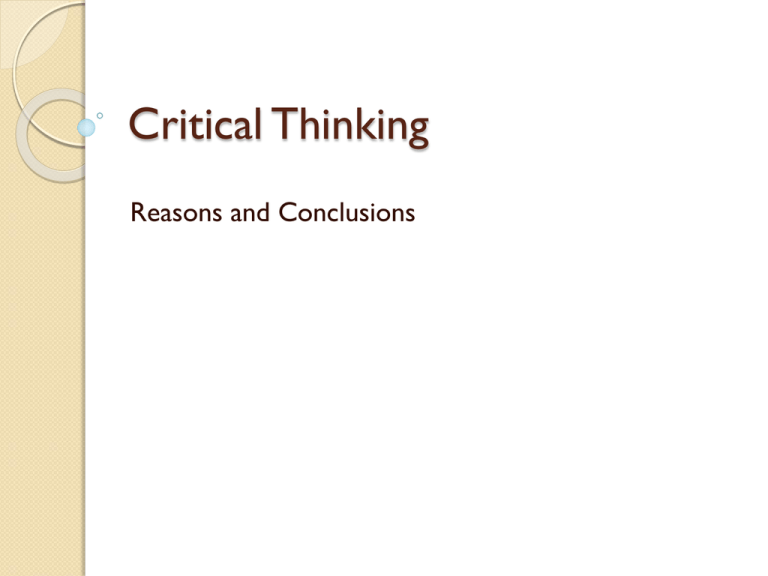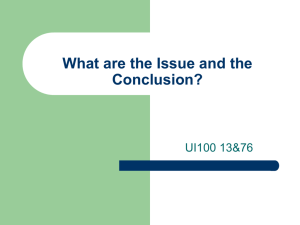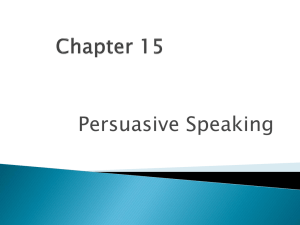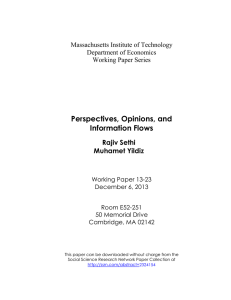Understanding Critical Thinking
advertisement

Critical Thinking Reasons and Conclusions Introduction to Critical Thinking Critical thinking is a term people use to refer to a process of investigation. ◦ The process is difficult to define because it used in so many different ways by so many different fields of study. Introduction to Critical Thinking Sometimes, critical thinking refers to a process of formal logic, which is based primarily on the relationship of reasons to the conclusion, independent of the degree to which the reasons are accurate. E.g. All rabbits can fly. This animal is a rabbit. Therefore, this animal can fly. Believe it or not, this argument is logical. It does not, however, correspond with reality. Introduction to Critical Thinking On other occasions, critical thinking refers to a larger process of reasoning in which the thinker moves from reasons to conclusions, operating with an awareness of both the logical connection between the reasons and the conclusions and an understanding of the degree to which the argument can be supported by factual evidence. Introduction to Critical Thinking People who have sought to teach critical thinking have assumed that it is a skill, like riding a bicycle, and that, like other skills, once you learn it, you can apply it in any situation. Research from cognitive science shows that thinking is not that sort of skill. The processes of thinking are intertwined with the content of thought (that is, domain knowledge). Thus, if you remind a student to “look at an issue from multiple perspectives” often enough, he will learn that he ought to do so, but if he doesn’t know much about an issue, he can’t think about it from multiple perspectives.” Daniel T. Willingham, Critical Thinking: Why Is It So Hard to Teach What is Critical Thinking? Critical thinking is a system of analysis through which one seeks to establish the validity of a proposition by: ◦ examining evidence; ◦ investigating rival causes; ◦ organizing evidence in accordance with the principles of formal reasoning; ◦ articulating a qualified conclusion. What is Critical Thinking The process of critical thinking ought to include an acknowledgement of the contingency of the conclusion. If the conclusion is held on the basis of evidence and the evidence changes or is shown to be erroneous, the conclusion must be re-examined. Argument In both cases, the process of critical thinking is based on a simple model of argument: reasons lead logically to a conclusion. Reasons Conclusion Opinion In the presentation of an opinion, the arguer might offer personal evidence in support of a position but that evidence does not lead logically to the conclusion. Reasons Conclusion Belief In the presentation of belief, the arguer may offer evidence but that evidence is usually based upon beliefs that the audience may not share. ◦ If the audience does not share the belief, the audience may not accept the evidence as compelling. Reasons Conclusion Critical Thinking “People who have sought to teach critical thinking have assumed that it is a skill, like riding a bicycle, and that, like other skills, once you learn it, you can apply it in any situation. Research from cognitive science shows that thinking is not that sort of skill. The processes of thinking are intertwined with the content of thought (that is, domain knowledge). Thus, if you remind a student to “look at an issue from multiple perspectives” often enough, he will learn that he ought to do so, but if he doesn’t know much about an issue, he can’t think about it from multiple perspectives.” Daniel T. Willingham, Critical Thinking: Why Is It So Hard to Teach? Critical Thinking “You can teach students maxims about how they ought to think, but without background knowledge and practice, they probably will not be able to implement the advice they memorize. Just as it makes no sense to try to teach factual content without giving students opportunities to practice using it, it also makes no sense to try to teach critical thinking devoid of factual content.” Daniel T. Willingham, Critical Thinking: Why Is It So Hard to Teach? Formal Logic Deductive Reasoning • P1 • P2 A=B B=C • CA = C • If the premises (i.e. P1 and P2) are true, then the conclusion must be true. Formal Logic • Inductive Reasoning • • • • P1 P2 P3 R1 evidence in support of proposition evidence in support of proposition evidence in support of proposition rival causes are investigated • Conclusion: The reasons above suggest that the particular conclusion is likely, but not inevitable. As one adds relevant evidence, the likelihood of the proposition increases. However, in inductive reasoning, the conclusion is always, to some degree, conditional. Critical Thinking: What are the reasons? • Every class should conclude with a student evaluation. • A pig is smarter than a dog. • Employers should be able to fire any employee who refuses to take a drug test. Critical Thinking: What are the reasons? Reasons & Conclusion = Argument Reasons are explanations or rationales for why we ought to accept a particular conclusion. Reasons are usually offered with the intention of convincing one’s audience. The audience should be aware of that intention. Not all reasons are good reasons. Not all good reasons are relevant. Critical Thinking: What are the reasons? Reasons vs. Beliefs ◦ Beliefs are personal and idiomatic. They are important because they inform our respective worldviews. However, because beliefs are often held in the absence of evidence, they do not permit critical examination. Reasons, by contrast, are relatively objective and available to scrutiny. Avoid reverse logic and backward reasoning ◦ Reverse logic occurs when we arrive at a conclusion first and then search for evidence to support it. The Effect of Critical Thinking 7. It is also important to understand that arguments based on critical thinking are not necessarily the most persuasive. Perhaps more often than not, the most persuasive arguments are those designed to appeal to our basic human/emotional needs rather than to our sense of objectivity. For that reason, it is common for highly persuasive arguments by politicians, TV evangelists, and sales people, among others, to intentionally lack critical thinking. End






